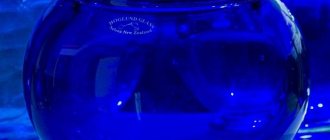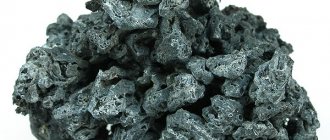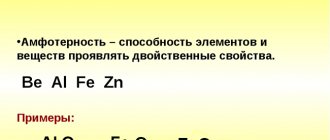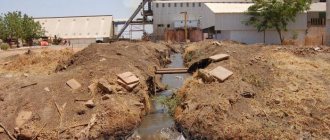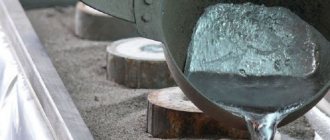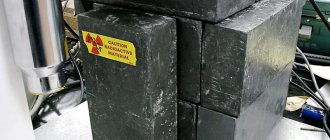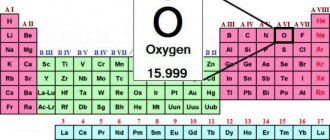| Copper(I) oxide | |
| Are common | |
| Traditional names | Cuprous oxide, cuprous oxide, dicopper oxide |
| Appearance | Brown-red crystals |
| Physical properties | |
| Molar mass | 143.09 g/mol |
| Density | 6.1 g/cm³ |
| Hardness | 3,5 — 4 |
| Thermal properties | |
| Melting enthalpy | +64.22 kJ/mol |
| Chemical properties | |
| Solubility in water | 2.4 10−7 g/100 ml |
| Optical properties | |
| Refractive index | 2,85 |
| Structure | |
| Crystal structure | cubic |
| Classification | |
| Reg. CAS number | 1317-39-1 |
| SMILES | [chemapps.stolaf.edu/jmol/jmol.php?model=%5BCu%5DO%5BCu%5D [Cu]O[Cu]] |
| Safety | |
| LD50 | 470 mg/kg |
| R-phrases | R22; R50/53 |
| S-phrases | S22; S60; S61 |
| H-phrases | H302; H410 |
| P-phrases | P273; P501 |
| Data given is based on standard conditions (25 °C, 100 kPa) unless otherwise stated. | |
Copper(I) oxide
(copper hemioxide, dicopper oxide,
obsolete
cuprous oxide) is a chemical compound with the formula \mathsf{Cu_2O}. Compound of copper with oxygen, basic oxide. Brown-red crystalline substance. It occurs in nature as the mineral cuprite.
Chemical properties
Reactions in aqueous solutions
Copper(I) oxide does not react with water. To a very small extent ( = 1.2·10−15) dissociates:
\mathsf{Cu_2O\ +\ H_2O\ \rightleftarrows\ 2Cu^+ +\ 2OH^-}
Disproportionation equilibrium:
\mathsf{2Cu^+\ \rightleftarrows\ Cu^{2+} \ +\ Cu}
Copper(I) oxide is transferred into solution:
- concentrated hydrochloric acid
\mathsf{Cu_2O\ +\ 4HCl\ \longrightarrow\ 2H[CuCl_2]\ +\ H_2O}
- concentrated alkali (partially)
\mathsf{Cu_2O\ +\ 2OH^-\ +\ H_2O\ \rightleftarrows\ 2[Cu(OH)_2]^-}
- concentrated ammonia hydrate and concentrated solutions of ammonium salts
\mathsf{Cu_2O\ +\ 4(NH_3 \cdot H_2O)\ \longrightarrow\ 2[Cu(NH_3)_2]OH\ +\ 3H_2O} \mathsf{Cu_2O\ +\ 2NH_4^+\ \longrightarrow\ 2[Cu( H_2O)(NH_3)]^+}
- by oxidation to copper(II) salts with various oxidizing agents (for example, concentrated nitric and sulfuric acids, oxygen in dilute hydrochloric acid)
\mathsf{Cu_2O\ +\ 6HNO_3\ \longrightarrow\ 2Cu(NO_3)_2\ +\ 2NO_2 \uparrow +\ 3H_2O} \mathsf{Cu_2O\ +\ 3H_2SO_4\ \longrightarrow\ 2CuSO_4\ +\ SO_2 \uparrow +\ 3H_2O} \mathsf{2Cu_2O\ +\ 8HCl\ +\ O_2\ \longrightarrow\ 4CuCl_2\ +\ 4H_2O}
Also, copper(I) oxide enters into the following reactions in aqueous solutions:
- slowly oxidized by oxygen to copper(II) hydroxide
\mathsf{2Cu_2O\ +\ 4H_2O\ +\ O_2\ \longrightarrow\ 4Cu(OH)_2 \downarrow}
- reacts with dilute hydrohalic acids to form the corresponding copper(I) halides:
\mathsf{Cu_2O\ +\ 2HHal\ \longrightarrow\ 2CuHal \downarrow +\ H_2O\ \ (Hal\ =\ Cl,\ Br,\ I)}
- in dilute sulfuric acid dismutates into copper(II) sulfate and metallic copper
\mathsf{Cu_2O\ +\ H_2SO_4\ \longrightarrow\ CuSO_4\ +\ Cu \downarrow +\ H_2O}
- reduced to copper metal by typical reducing agents, e.g. sodium hydrogen sulfite in concentrated solution
\mathsf{2Cu_2O\ +\ 2NaHSO_3\ \longrightarrow\ 4Cu \downarrow +\ Na_2SO_4\ +\ H_2SO_4}
Reactions at high temperatures
Copper(I) oxide is reduced to copper metal in the following reactions:
- when heated to 1800 °C (decomposition)
\mathsf{2Cu_2O\ \xrightarrow{1800\ ^\circ C}\ 4Cu\ +\ O_2}
- when heated in a stream of hydrogen, carbon monoxide, with aluminum
\mathsf{Cu_2O\ +\ H_2\ \xrightarrow{>250\ ^\circ C}\ 2Cu\ +\ H_2O} \mathsf{Cu_2O\ +\ CO\ \xrightarrow{250-300\ ^\circ C}\ 2Cu \ +\ CO_2} \mathsf{3Cu_2O\ +\ 2Al\ \xrightarrow{1000\ ^\circ C}\ 6Cu\ +\ Al_2O_3}
- when heated with sulfur
\mathsf{2Cu_2O\ +\ 3S\ \xrightarrow{>600\ ^\circ C}\ 2Cu_2S\ +\ SO_2} \mathsf{2Cu_2O\ +\ Cu_2S\ \xrightarrow{1200-1300\ ^\circ C}\ 6Cu \ +\ SO_2}
Copper(I) oxide can be oxidized to copper(II) compounds in a stream of oxygen or chlorine:
\mathsf{2Cu_2O\ +\ O_2\ \xrightarrow{500\ ^\circ C}\ 4CuO} \mathsf{Cu_2O\ +\ Cl_2\ \xrightarrow{250\ ^\circ C}\ Cu_2Cl_2O}
Also, at high temperatures, copper(I) oxide reacts:
- with ammonia (copper(I) nitride is formed)
\mathsf{3Cu_2O\ +\ 2NH_3\ \xrightarrow{250\ ^\circ C}\ 2Cu_3N\ +\ 3H_2O}
- with oxides of alkali metals and barium (double oxides are formed)
\mathsf{Cu_2O\ +\ M_2O\ \xrightarrow{600-800\ ^\circ C}\ 2MCuO} \mathsf{Cu_2O\ +\ BaO\ \xrightarrow{500-600\ ^\circ C}\ BaCu_2O_2}
Other reactions
Copper(I) oxide reacts with hydrogen azide:
- upon cooling, a precipitate of copper(II) azide precipitates
\mathsf{Cu_2O\ +\ 5HN_3\ \xrightarrow{10-15\ ^\circ C}\ 2Cu(N_3)_2 \downarrow +\ H_2O\ +\ NH_3 \uparrow +\ N_2 \uparrow}
- at room temperature, a copper(I) azide precipitates in a stream of hydroazidic acid
\mathsf{Cu_2O\ +\ 2HN_3\ \xrightarrow{20-25\ ^\circ C}\ 2CuN_3 \downarrow +\ H_2O}
Copper oxide
Cuprum (Cu) is one of the low-active metals. It is characterized by the formation of chemical compounds with oxidation states +1 and +2. So, for example, two oxides, which are a compound of two elements Cu and oxygen O: with an oxidation state of +1 - copper oxide Cu2O and an oxidation state of +2 - copper oxide CuO. Despite the fact that they consist of the same chemical elements, each of them has its own special characteristics. In the cold, the metal interacts very weakly with air oxygen, becoming covered with a film of copper oxide, which prevents further oxidation of cuprum. When heated, this simple substance with serial number 29 in the periodic table is completely oxidized. In this case, copper (II) oxide is also formed: 2Cu + O2 → 2CuO.
Nitrous oxide is a brownish-red solid with a molar mass of 143.1 g/mol. The compound has a melting point of 1235°C and a boiling point of 1800°C. It is insoluble in water, but soluble in acids. Copper oxide (I) is diluted in ammonia solution (concentrated), resulting in the formation of a colorless complex +, which is easily oxidized in air to a blue-violet ammonia complex 2+, dissolving in hydrochloric acid to form CuCl2. In the history of semiconductor physics, Cu2O is one of the most studied materials.
Copper(I) oxide, also known as hemioxide, has basic properties. It can be obtained by oxidation of the metal: 4Cu + O2 → 2 Cu2O. Impurities such as water and acids affect the rate of this process, as well as further oxidation to divalent oxide. Cuprous oxide can dissolve in sulfuric acid, resulting in the formation of pure metal and salt: H2SO4 + Cu2O → Cu + CuSO4 + H2O. According to a similar scheme, the interaction of an oxide with the oxidation state of the metal +1 with other oxygen-containing acids occurs. When hemioxide reacts with halogen-containing acids, monovalent metal salts are formed: 2HCl + Cu2O → 2CuCl + H2O.
Copper(I) oxide occurs naturally in the form of red ore (an obsolete name, along with ruby Cu), called the mineral "Cuprite". It takes a long time to form. It can be produced artificially at high temperatures or under high oxygen pressure. Hemioxide is commonly used as a fungicide, as a pigment, as an antifouling agent in underwater or marine paint, and is also used as a catalyst.
However, the effects of this substance with the chemical formula Cu2O on the body can be dangerous. If inhaled, causes shortness of breath, cough, and ulceration and perforation of the respiratory tract. If ingested, it irritates the gastrointestinal tract, which is accompanied by vomiting, pain and diarrhea.
Higher copper oxide is a brown to black powder in appearance. In nature, it is found in its pure form as the mineral “Tenorite”. Its melting point is 1326°C, boiling point is 2000°C. It is insoluble in water, alcohol, ammonium hydroxide, ammonium carbonate solution. Soluble in aqueous solutions of ammonium chloride and potassium cyanide. This black solid can be produced by heating Cu in air. However, in this case, Cu oxide is also formed. The production of copper oxide CuO is possible by heating the following compounds:
- copper (II) nitrate 2Cu(NO3)2 → 4 NO2+ O2 + 2CuO;
- copper (II) hydroxide Cu(OH)2 → H2O + CuO;
- copper (II) carbonate CuCO3 → CO2 + CuO.
Cuprum(II) oxide is basic, so it dissolves in mineral acids (hydrochloric, sulfuric and nitric) to give the corresponding divalent Cu salt:
- 2HCl + CuO → CuCl2 + H2O;
- H2SO4 + CuO → CuSO4 + H2O;
- 2HNO3 + CuO → Cu(NO3)2 + H2O.
Copper (II) oxide reacts with concentrated alkali to form a salt: 2 KOH + CuO + H2O → K2.
The oxide can also be reduced to metallic Cu by reaction with hydrogen or carbon monoxide:
- H2 + CuO → Cu + H2O;
- CO + CuO → Cu + CO2.
Copper(II) oxide is used in ceramics (as a pigment) to produce glazes (blue, green and red, and sometimes pink, gray or black). It is also used as a dietary supplement in animals to reduce cuprum deficiency in the body. This is an abrasive material that is necessary for polishing optical equipment. It is used for the production of dry batteries, to obtain other Cu salts. The CuO compound is also used in welding copper alloys.
Exposure to the chemical compound CuO can also be dangerous to the human body. Causes lung irritation if inhaled. Copper(II) oxide can cause metal fume fever (MFF). Cu oxide causes skin discoloration and vision problems may occur. If it enters the body, like hemioxide, it leads to poisoning, which is accompanied by symptoms in the form of vomiting and pain.
Receipt
Copper(I) oxide can be obtained:
- heating copper metal in the absence of oxygen
\mathsf{4Cu\ +\ O_2\ \xrightarrow{>200\ ^\circ C}\ 2Cu_2O}
- heating copper metal in a stream of nitric oxide (I) or nitric oxide (II)
\mathsf{2Cu\ +\ N_2O\ \xrightarrow{500-600\ ^\circ C}\ Cu_2O\ +\ N_2} \mathsf{4Cu\ +\ 2NO\ \xrightarrow{500-600\ ^\circ C}\ 2Cu_2O\ +\ N_2}
- heating copper metal with copper(II) oxide
\mathsf{Cu\ +\ CuO\ \xrightarrow{1000-1200\ ^\circ C}\ Cu_2O}
- thermal decomposition of copper(II) oxide
\mathsf{4CuO\ \xrightarrow{1026-1100\ ^\circ C}\ 2Cu_2O\ +\ O_2}
- heating copper(I) sulfide in a stream of oxygen
\mathsf{2Cu_2S\ +\ 3O_2\ \xrightarrow{1200-1300\ ^\circ C}\ 2Cu_2O\ +\ 2SO_2}
In laboratory conditions, copper(I) oxide can be obtained by reducing copper(II) hydroxide (for example, with hydrazine) :
\mathsf{4Cu(OH)_2\ +\ N_2H_4 \cdot H_2O\ \xrightarrow{100\ ^\circ C}\ 2Cu_2O \downarrow +\ N_2 \uparrow +\ 7H_2O}
Also, copper(I) oxide is formed in ion exchange reactions of copper(I) salts with alkalis, for example:
- in the reaction of copper(I) iodide with a hot concentrated solution of potassium hydroxide
\mathsf{2CuI\ +\ 2KOH\ \longrightarrow\ Cu_2O \downarrow +\ 2KI\ +\ H_2O}
- in the reaction of hydrogen dichlorocuprate(I) with a dilute solution of sodium hydroxide
\mathsf{2H[CuCl_2]\ +\ 4NaOH\ \longrightarrow\ Cu_2O \downarrow +\ 4NaCl\ +\ 3H_2O}
In the last two reactions, a compound with a composition corresponding to the formula \mathsf{CuOH} (copper(I) hydroxide) is not formed . The formation of copper(I) oxide occurs through an intermediate hydrate form of variable composition \mathsf{Cu_2O \cdot xH_2O}.[5]
- Oxidation of aldehydes copper(II) hydroxide. If an aldehyde solution is added to the blue precipitate of copper(II) hydroxide and the mixture is heated, then a yellow precipitate of copper(I) hydroxide appears first:
\mathsf{R-CHO + 2Cu(OH)_2 \ \xrightarrow[]{t}\ R-COOH + 2CuOH\downarrow + H_2O } upon further heating, the yellow precipitate of copper (I) hydroxide turns into red copper (I) oxide: \mathsf{2CuOH \ \xrightarrow[]{t}\ Cu_2O + H_2O }
Physical properties:
| 200 | Physical properties |
| 201 | Density |
| 202 | Melting temperature |
| 203 | Boiling temperature |
| 204 | Sublimation temperature |
| 205 | Decomposition temperature* |
| 206 | Self-ignition temperature of a gas-air mixture |
| 207 | Specific heat of fusion (enthalpy of fusion ΔHpl) |
| 208 | Specific heat of evaporation (enthalpy of boiling ΔHboiling) |
| 209 | Specific heat capacity at constant pressure |
| 210 | Molar heat capacity |
| 211 | Molar volume |
| 212 | Thermal conductivity |
| 213 | Thermal expansion coefficient |
| 214 | Thermal diffusivity coefficient |
| 215 | Critical temperature |
| 216 | Critical pressure |
| 217 | Critical Density |
| 218 | Triple point |
| 219 | Solubility in water and other liquids |
| 220 | Vapor pressure (mmHg) |
| 221 | Vapor pressure (Pa) |
| 222 | Standard enthalpy of formation ΔH |
| 223 | Standard Gibbs energy of formation ΔG |
| 224 | Standard entropy of matter S |
| 225 | Standard molar heat capacity Cp |
| 226 | Enthalpy of dissociation ΔHdiss |
| 227 | The dielectric constant |
| 228 | Magnetic type |
| 229 | Curie point |
| 230 | Neel temperature |
| 231 | Volume magnetic susceptibility |
| 232 | Specific magnetic susceptibility |
| 233 | Molar magnetic susceptibility |
| 234 | Electric type |
| 235 | Electrical conductivity in the solid phase |
| 236 | Electrical resistivity |
| 237 | Superconductivity at temperature |
| 238 | Critical magnetic field of superconductivity destruction |
| 239 | Prohibited area |
| 240 | Charge carrier concentration |
| 241 | Mohs hardness |
| 242 | Brinell hardness |
| 243 | Vickers hardness |
| 244 | Sound speed |
| 245 | Surface tension |
| 246 | Dynamic viscosity of gases and liquids |
| 246 | Explosive concentrations of gas-air mixture, % volume |
| 247 | Explosive concentrations of a mixture of gas and oxygen, % volume |
| 248 | Ultimate tensile strength |
| 249 | Yield strength |
| 250 | Elongation limit |
| 251 | Young's modulus |
| 252 | Shear modulus |
| 253 | Bulk modulus of elasticity |
| 254 | Poisson's ratio |
| 255 | Refractive index |
Notes
- [webmineral.com/data/Cuprite.shtml Cuprite at webmineral.com]
- ↑ 1 2 Lidin R.A., Andreeva L.L., Molochko V.A.
Constants of inorganic substances: a reference book / Ed. R. A. Lidina. — 2nd ed., revised. and additional - M.: Bustard, 2006. - P. 104, 226, 464, 532, 604. - 685 p. — ISBN 5-7107-8085-5. - Lidin R. A., Molochko V. A., Andreeva L. L.
Reactions of inorganic substances: a reference book / Ed. R. A. Lidina. — 2nd ed., revised. and additional - M.: Bustard, 2007. - P. 148-149. — 637 p. — ISBN 978-5-358-01303-2. - ↑ 12
[www.xumuk.ru/encyklopedia/2461.html Copper oxides at xumuk.ru]. [www.webcitation.org/65SoQOroJ Archived from the original on February 15, 2012]. - [www.xumuk.ru/encyklopedia/2458.html Copper hydroxides at xumuk.ru]. [www.webcitation.org/65SoS6yGo Archived from the original on February 15, 2012].
Copper compounds. Oxides and hydroxides. Complex connections
Copper (lat. Cuprum) is a chemical element of group I of the periodic system of Mendeleev (atomic number 29, atomic mass 63.546). In compounds, copper usually exhibits oxidation states +1 and +2; a few trivalent copper compounds are also known. The most important copper compounds: oxides Cu2O, CuO, Cu2O3; hydroxide Cu(OH)2, nitrate Cu(NO3)2.3H2O, sulfide CuS, sulfate (copper sulfate) CuSO4.5H2O, carbonate CuCO3.Cu(OH)2, chloride CuCl2.2H2O.
Pure copper is a malleable and soft metal of a reddish color, pink when fractured, in places with brown and mottled tarnish, heavy (density 8.93 g/cm3), an excellent conductor of heat and electricity, second in this regard only to silver (melting point 1083oC). Copper is easily drawn into wire and rolled into thin sheets, but has relatively little activity. In dry air and oxygen under normal conditions, copper does not oxidize. But it reacts quite easily: already at room temperature it forms CuCl2 chloride with halogens, for example with wet chlorine; when heated with sulfur it forms Cu2S sulfide, with selenium. But copper does not interact with hydrogen, carbon and nitrogen even at high temperatures. Acids that do not have oxidizing properties do not act on copper, for example, hydrochloric and dilute sulfuric acids. But in the presence of atmospheric oxygen, copper dissolves in these acids to form the corresponding salts:
2Cu + 4HCl + O2 = 2CuCl2 + 2H2O.
In an atmosphere containing CO2, H2O vapors, etc., it becomes covered with patina - a greenish film of basic carbonate (Cu2(OH)2CO3)), a toxic substance.
Copper is found in more than 170 minerals, of which only 17 are important for industry, including: bornite (variegated copper ore - Cu5FeS4), chalcopyrite (copper pyrite - CuFeS2), chalcocite (copper luster - Cu2S), covellite (CuS), malachite (Cu2(OH)2CO3). Native copper is also found
Copper (I) oxide Cu2O3 and cuprous oxide (I) Cu2O , like other copper (I) compounds, are less stable than copper (II) compounds. Copper (I) oxide, or cuprous oxide Cu2O, occurs naturally as the mineral cuprite. In addition, it can be obtained as a precipitate of red copper(I) oxide by heating a solution of a copper(II) salt and an alkali in the presence of a strong reducing agent. Copper(II) oxide, or copper oxide, CuO is a black substance found in nature (for example, as the mineral tenerite). It is obtained by calcination of copper (II) hydroxycarbonate (CuOH)2CO3 or copper (II) nitrate Cu(NO2)2. Copper(II) oxide is a good oxidizing agent. Copper (II) hydroxide Cu(OH)2 precipitates from solutions of copper (II) salts under the action of alkalis in the form of a blue gelatinous mass. Even with low heating, even under water, it decomposes, turning into black copper (II) oxide. Copper(II) hydroxide is a very weak base. Therefore, solutions of copper (II) salts in most cases have an acidic reaction, and with weak acids copper forms basic salts. Copper (II) sulfate CuSO4 in the anhydrous state is a white powder that turns blue when it absorbs water. Therefore, it is used to detect traces of moisture in organic liquids. An aqueous solution of copper sulfate has a characteristic blue-blue color. This color is characteristic of hydrated [Cu(H2O)4]2+ ions, therefore all dilute solutions of copper (II) salts have the same color, unless they contain any colored anions. From aqueous solutions, copper sulfate crystallizes with five molecules of water, forming transparent blue crystals of copper sulfate. Copper sulfate is used for electrolytic coating of metals with copper, for the preparation of mineral paints, and also as a starting material in the preparation of other copper compounds. In agriculture, a diluted solution of copper sulfate is used to spray plants and treat grain before sowing to destroy spores of harmful fungi. Copper (II) chloride CuCl2. 2H2O. Forms dark green crystals, easily soluble in water. Very concentrated solutions of copper (II) chloride are green, diluted solutions are blue-blue. Copper (II) nitrate Cu(NO3)2.3H2O. It is obtained by dissolving copper in nitric acid. When heated, blue copper nitrate crystals first lose water and then easily decompose, releasing oxygen and brown nitrogen dioxide, turning into copper (II) oxide. Copper (II) hydroxycarbonate (CuOH)2CO3. It occurs naturally in the form of the mineral malachite, which has a beautiful emerald green color. It is artificially prepared by the action of Na2CO3 on solutions of copper (II) salts. 2CuSO4 + 2Na2CO3 + H2O = (CuOH)2CO3v + 2Na2SO4 + CO2^ Used to obtain copper (II) chloride, for the preparation of blue and green mineral paints, as well as in pyrotechnics. Copper (II) acetate Cu (CH3COO)2.H2O. It is obtained by treating copper metal or copper(II) oxide with acetic acid. Usually it is a mixture of basic salts of various compositions and colors (green and blue-green). Under the name verdigris, it is used to prepare oil paint. Complex copper compounds are formed as a result of the combination of doubly charged copper ions with ammonia molecules. A variety of mineral paints are obtained from copper salts. All copper salts are poisonous. Therefore, to avoid the formation of copper salts, copper utensils are coated on the inside with a layer of tin (tinned).
Copper (lat. Cuprum) is a chemical element of group I of the periodic system of Mendeleev (atomic number 29, atomic mass 63.546). In compounds, copper usually exhibits oxidation states +1 and +2; a few trivalent copper compounds are also known. The most important copper compounds: oxides Cu2O, CuO, Cu2O3; hydroxide Cu(OH)2, nitrate Cu(NO3)2.3H2O, sulfide CuS, sulfate (copper sulfate) CuSO4.5H2O, carbonate CuCO3.Cu(OH)2, chloride CuCl2.2H2O.
Pure copper is a malleable and soft metal of a reddish color, pink when fractured, in places with brown and mottled tarnish, heavy (density 8.93 g/cm3), an excellent conductor of heat and electricity, second in this regard only to silver (melting point 1083oC). Copper is easily drawn into wire and rolled into thin sheets, but has relatively little activity. In dry air and oxygen under normal conditions, copper does not oxidize. But it reacts quite easily: already at room temperature it forms CuCl2 chloride with halogens, for example with wet chlorine; when heated with sulfur it forms Cu2S sulfide, with selenium. But copper does not interact with hydrogen, carbon and nitrogen even at high temperatures. Acids that do not have oxidizing properties do not act on copper, for example, hydrochloric and dilute sulfuric acids. But in the presence of atmospheric oxygen, copper dissolves in these acids to form the corresponding salts:
2Cu + 4HCl + O2 = 2CuCl2 + 2H2O.
In an atmosphere containing CO2, H2O vapors, etc., it becomes covered with patina - a greenish film of basic carbonate (Cu2(OH)2CO3)), a toxic substance.
Copper is found in more than 170 minerals, of which only 17 are important for industry, including: bornite (variegated copper ore - Cu5FeS4), chalcopyrite (copper pyrite - CuFeS2), chalcocite (copper luster - Cu2S), covellite (CuS), malachite (Cu2(OH)2CO3). Native copper is also found
Copper (I) oxide Cu2O3 and cuprous oxide (I) Cu2O , like other copper (I) compounds, are less stable than copper (II) compounds. Copper (I) oxide, or cuprous oxide Cu2O, occurs naturally as the mineral cuprite. In addition, it can be obtained as a precipitate of red copper(I) oxide by heating a solution of a copper(II) salt and an alkali in the presence of a strong reducing agent. Copper(II) oxide, or copper oxide, CuO is a black substance found in nature (for example, as the mineral tenerite). It is obtained by calcination of copper (II) hydroxycarbonate (CuOH)2CO3 or copper (II) nitrate Cu(NO2)2. Copper(II) oxide is a good oxidizing agent. Copper (II) hydroxide Cu(OH)2 precipitates from solutions of copper (II) salts under the action of alkalis in the form of a blue gelatinous mass. Even with low heating, even under water, it decomposes, turning into black copper (II) oxide. Copper(II) hydroxide is a very weak base. Therefore, solutions of copper (II) salts in most cases have an acidic reaction, and with weak acids copper forms basic salts. Copper (II) sulfate CuSO4 in the anhydrous state is a white powder that turns blue when it absorbs water. Therefore, it is used to detect traces of moisture in organic liquids. An aqueous solution of copper sulfate has a characteristic blue-blue color. This color is characteristic of hydrated [Cu(H2O)4]2+ ions, therefore all dilute solutions of copper (II) salts have the same color, unless they contain any colored anions. From aqueous solutions, copper sulfate crystallizes with five molecules of water, forming transparent blue crystals of copper sulfate. Copper sulfate is used for electrolytic coating of metals with copper, for the preparation of mineral paints, and also as a starting material in the preparation of other copper compounds. In agriculture, a diluted solution of copper sulfate is used to spray plants and treat grain before sowing to destroy spores of harmful fungi. Copper (II) chloride CuCl2. 2H2O. Forms dark green crystals, easily soluble in water. Very concentrated solutions of copper (II) chloride are green, diluted solutions are blue-blue. Copper (II) nitrate Cu(NO3)2.3H2O. It is obtained by dissolving copper in nitric acid. When heated, blue copper nitrate crystals first lose water and then easily decompose, releasing oxygen and brown nitrogen dioxide, turning into copper (II) oxide. Copper (II) hydroxycarbonate (CuOH)2CO3. It occurs naturally in the form of the mineral malachite, which has a beautiful emerald green color. It is artificially prepared by the action of Na2CO3 on solutions of copper (II) salts. 2CuSO4 + 2Na2CO3 + H2O = (CuOH)2CO3v + 2Na2SO4 + CO2^ Used to obtain copper (II) chloride, for the preparation of blue and green mineral paints, as well as in pyrotechnics. Copper (II) acetate Cu (CH3COO)2.H2O. It is obtained by treating copper metal or copper(II) oxide with acetic acid. Usually it is a mixture of basic salts of various compositions and colors (green and blue-green). Under the name verdigris, it is used to prepare oil paint. Complex copper compounds are formed as a result of the combination of doubly charged copper ions with ammonia molecules. A variety of mineral paints are obtained from copper salts. All copper salts are poisonous. Therefore, to avoid the formation of copper salts, copper utensils are coated on the inside with a layer of tin (tinned).
Excerpt characterizing Copper(I) Oxide
- That's right, sir. They already know where to stand. They know how to drive so subtly that sometimes Danila and I are amazed,” said Semyon, knowing how to please the master. - It drives well, huh? And what about the horse, huh? - Paint a picture! Just the other day, a fox was snatched from the Zavarzinsky weeds. They began to jump over, out of delight, passion - the horse is a thousand rubles, but the rider has no price. Look for such a fine fellow! “Search...,” the count repeated, apparently regretting that Semyon’s speech ended so soon. - Search? - he said, turning away the flaps of his fur coat and taking out a snuff box. “The other day, as Mikhail Sidorich came out from mass in full regalia...” Semyon did not finish, hearing the rut clearly heard in the quiet air with the howling of no more than two or three hounds. He bowed his head, listened and silently threatened the master. “They’ve attacked the brood...” he whispered, and they led him straight to Lyadovskaya. The count, having forgotten to wipe the smile from his face, looked ahead along the lintel into the distance and, without sniffing, held the snuffbox in his hand. Following the barking of the dogs, a voice was heard from the wolf, sent into Danila’s bass horn; the pack joined the first three dogs and the voices of the hounds could be heard roaring loudly, with that special howl that served as a sign of the rutting of the wolf. Those arriving no longer squawked, but hooted, and from behind all the voices came Danila’s voice, sometimes bassy, sometimes piercingly thin. Danila’s voice seemed to fill the entire forest, came out from behind the forest and sounded far into the field. After listening in silence for a few seconds, the count and his stirrup became convinced that the hounds had split into two flocks: one large one, roaring especially hotly, began to move away, the other part of the flock rushed along the forest past the count, and in the presence of this flock Danila’s hooting could be heard. Both of these ruts merged, shimmered, but both moved away. Semyon sighed and bent down to straighten the bundle in which the young male was entangled; The count also sighed and, noticing the snuff-box in his hand, opened it and took out a pinch. "Back!" Semyon shouted at the dog, who stepped out beyond the edge. The Count shuddered and dropped his snuffbox. Nastasya Ivanovna got down and began to lift her. The Count and Semyon looked at him. Suddenly, as often happens, the sound of the rut instantly came closer, as if, right there in front of them, there were the barking mouths of dogs and the hooting of Danila. The count looked around and to the right he saw Mitka, who was looking at the count with rolling eyes and, raising his hat, pointed him forward, to the other side. - Take care! - he shouted in such a voice that it was clear that this word had been painfully asking him to come out for a long time. And he galloped, releasing the dogs, towards the count. The Count and Semyon jumped out of the edge of the forest and to their left they saw a wolf, which, softly waddling, quietly jumped up to their left to the very edge at which they were standing. The evil dogs squealed and, breaking away from the pack, rushed towards the wolf past the legs of the horses. The wolf stopped running, awkwardly, like a sick toad, turned his big forehead to the dogs, and also softly waddling, jumped once, twice and, shaking a log (tail), disappeared into the edge of the forest. At that same moment, from the opposite edge of the forest, with a roar similar to crying, one, another, a third hound jumped out in confusion, and the whole pack rushed across the field, through the very place where the wolf had crawled (ran) through. Following the hounds, the hazel bushes parted and Danila’s brown horse, blackened with sweat, appeared. On her long back, in a lump, lolling forward, sat Danila, without a hat, with gray, tousled hair over a red, sweaty face. “Whoop, whoop!” he shouted. When he saw the count, lightning flashed in his eyes. “F...” he shouted, threatening the count with his raised arapnik. -About...the wolf!...hunters! - And as if not deigning the embarrassed, frightened count with further conversation, he, with all the anger he had prepared for the count, hit the sunken wet sides of the brown gelding and rushed after the hounds. The Count, as if punished, stood looking around and trying with a smile to make Semyon regret his situation. But Semyon was no longer there: he, taking a detour through the bushes, jumped the wolf from the abatis. Greyhounds also jumped over the beast from both sides. But the wolf walked through the bushes and not a single hunter intercepted him. Nikolai Rostov, meanwhile, stood in his place, waiting for the beast. By the approach and distance of the rut, by the sounds of the voices of dogs known to him, by the approach, distance and elevation of the voices of those arriving, he felt what was happening on the island. He knew that there were arrived (young) and seasoned (old) wolves on the island; he knew that the hounds had split into two packs, that they were poisoning somewhere, and that something untoward had happened. Every second he waited for the beast to come to his side. He made thousands of different assumptions about how and from which side the animal would run and how it would poison it. Hope gave way to despair. Several times he turned to God with a prayer for the wolf to come out to him; he prayed with that passionate and conscientious feeling with which people pray in moments of great excitement, depending on an insignificant reason. “Well, what does it cost you,” he said to God, “to do this for me! I know that You are great, and that it is a sin to ask You for this; but for the sake of God, make sure that the seasoned one comes out on me, and that Karai, in front of the “uncle” who is looking over there, slams into his throat with a death grip.” A thousand times during these half-hours, with a persistent, intense and restless gaze, Rostov looked around the edge of the forests with two sparse oak trees over an aspen undergrowth, and the ravine with a worn edge, and the uncle’s hat, barely visible from behind a bush to the right. “No, this happiness will not happen,” thought Rostov, but what would it cost? Will not be! I always have misfortune, both in cards and in war, in everything.” Austerlitz and Dolokhov flashed brightly, but quickly changing, in his imagination. “Only once in my life would I hunt down a seasoned wolf, I don’t want to do it again!” he thought, straining his hearing and vision, looking to the left and again to the right and listening to the slightest shades of the sounds of the rut. He looked again to the right and saw something running towards him across the deserted field. “No, this can’t be!” thought Rostov, sighing heavily, like a man sighs when he accomplishes something that has been long awaited by him. The greatest happiness happened - and so simply, without noise, without glitter, without commemoration. Rostov could not believe his eyes and this doubt lasted more than a second. The wolf ran forward and jumped heavily over the pothole that was on his road. It was an old beast, with a gray back and a full, reddish belly. He ran slowly, apparently convinced that no one could see him. Without breathing, Rostov looked back at the dogs. They lay and stood, not seeing the wolf and not understanding anything. Old Karai, turning his head and baring his yellow teeth, angrily looking for a flea, clicked them on his hind thighs. - Hoot! – Rostov said in a whisper, his lips protruding. The dogs, trembling their glands, jumped up, ears pricked. Karai scratched his thigh and stood up, pricking his ears and slightly shaking his tail, on which felts of fur hung. – Let in or not let in? - Nikolai said to himself while the wolf moved towards him, separating from the forest. Suddenly the whole face of the wolf changed; he shuddered, seeing human eyes that he had probably never seen before, fixed on him, and turning his head slightly towards the hunter, he stopped - back or forward? Eh! anyway, forward!... obviously,” he seemed to say to himself, and set off forward, no longer looking back, with a soft, rare, free, but decisive leap. “Whoops!...” Nikolai shouted in a voice that was not his own, and of its own accord his good horse rushed headlong down the hill, jumping over water holes and across the wolf; and the dogs rushed even faster, overtaking her. Nikolai did not hear his cry, did not feel that he was galloping, did not see either the dogs or the place where he was galloping; he saw only the wolf, who, intensifying his run, galloped, without changing direction, along the ravine. The first to appear near the beast was the black-spotted, wide-bottomed Milka and began to approach the beast. Closer, closer... now she came to him. But the wolf glanced slightly sideways at her, and instead of attacking her, as she always did, Milka suddenly raised her tail and began to rest on her front legs. - Whoop! - Nikolai shouted. Red Lyubim jumped out from behind Milka, quickly rushed at the wolf and grabbed him by the hachi (hips of his hind legs), but at that very second he jumped in fear to the other side. The wolf sat down, clicked his teeth and got up again and galloped forward, escorted a yard away by all the dogs that did not approach him. - He will go away! No, It is Immpossible! – Nikolai thought, continuing to scream in a hoarse voice. - Karai! Hoot!...” he shouted, looking with the eyes of the old dog, his only hope. Karai, with all his old strength, stretched out as much as he could, looking at the wolf, galloped heavily away from the beast, across it. But from the speed of the wolf’s leap and the slowness of the dog’s leap, it was clear that Karai’s calculation was wrong. Nikolai could no longer see the forest far ahead of him, which, having reached it, the wolf would probably leave. Dogs and a hunter appeared ahead, galloping almost towards them. There was still hope. Unknown to Nikolai, a dark, young, long male from someone else's pack quickly flew up to the wolf in front and almost knocked him over. The wolf quickly, as could not have been expected from him, stood up and rushed towards the dark dog, snapped his teeth - and the bloody dog, with a torn side, squealed shrilly and stuck his head into the ground. - Karayushka! Father!.. - Nikolai cried... The old dog, with his tufts dangling on his thighs, thanks to the stop that had taken place, cutting off the wolf’s path, was already five steps away from him. As if sensing danger, the wolf glanced sideways at Karai, hid the log (tail) even further between his legs and increased his gallop. But here - Nikolai only saw that something had happened to Karai - he instantly found himself on the wolf and together with him fell head over heels into the waterhole that was in front of them. The moment when Nikolai saw the dogs swarming with the wolf in the pond, from under which one could see the wolf’s gray fur, his outstretched back leg, and his frightened and choking head with his ears pressed back (Karai was holding him by the throat), the minute when Nikolai saw this was the happiest moment of his life. He had already taken hold of the pommel of the saddle to dismount and stab the wolf, when suddenly the animal’s head poked up from this mass of dogs, then its front legs stood on the edge of the waterhole. The wolf flashed his teeth (Karai was no longer holding him by the throat), jumped out of the pond with his hind legs and, tucking his tail, again separated from the dogs, moved forward. Karai with bristling fur, probably bruised or wounded, had difficulty crawling out of the waterhole. - My God! For what?...” Nikolai shouted in despair. The uncle's hunter, on the other side, galloped to cut off the wolf, and his dogs again stopped the beast. They surrounded him again.
